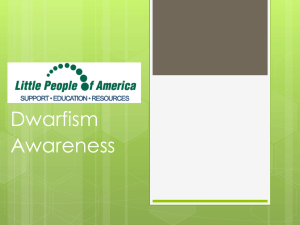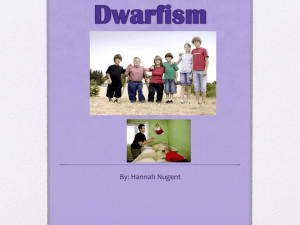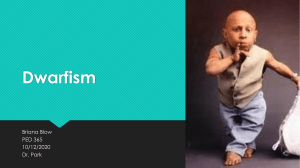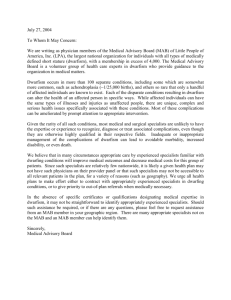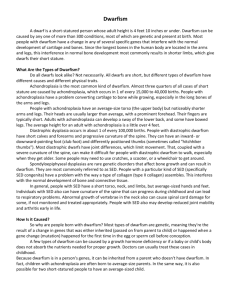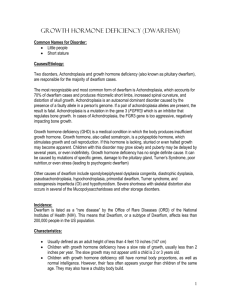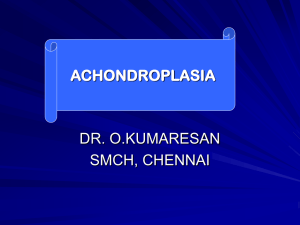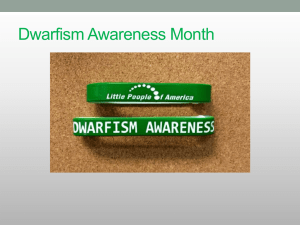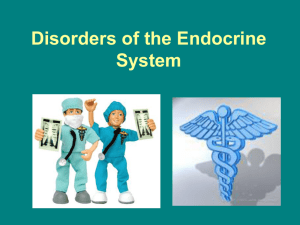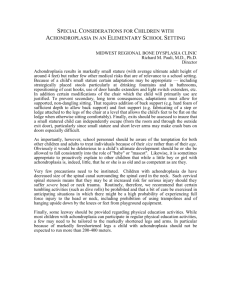Dwarfism - WCUGradAdaptedPE
advertisement
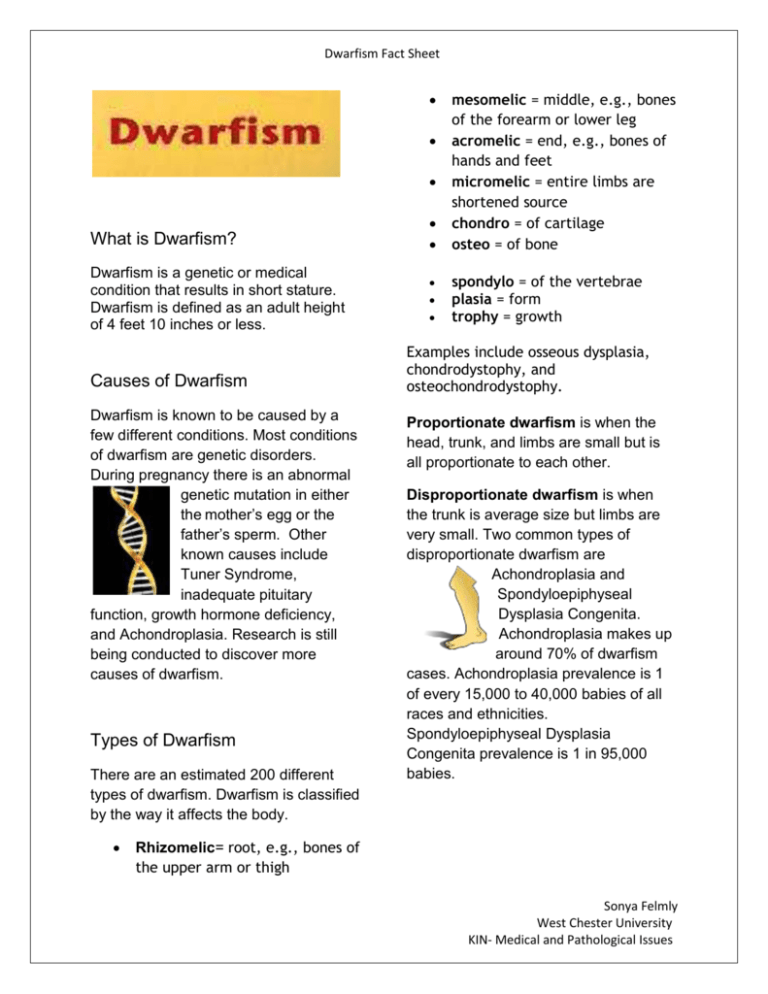
Dwarfism Fact Sheet mesomelic = middle, e.g., bones of the forearm or lower leg acromelic = end, e.g., bones of hands and feet micromelic = entire limbs are shortened source chondro = of cartilage osteo = of bone spondylo = of the vertebrae plasia = form trophy = growth What is Dwarfism? Dwarfism is a genetic or medical condition that results in short stature. Dwarfism is defined as an adult height of 4 feet 10 inches or less. Causes of Dwarfism Dwarfism is known to be caused by a few different conditions. Most conditions of dwarfism are genetic disorders. During pregnancy there is an abnormal genetic mutation in either the mother’s egg or the father’s sperm. Other known causes include Tuner Syndrome, inadequate pituitary function, growth hormone deficiency, and Achondroplasia. Research is still being conducted to discover more causes of dwarfism. Types of Dwarfism There are an estimated 200 different types of dwarfism. Dwarfism is classified by the way it affects the body. Examples include osseous dysplasia, chondrodystophy, and osteochondrodystophy. Proportionate dwarfism is when the head, trunk, and limbs are small but is all proportionate to each other. Disproportionate dwarfism is when the trunk is average size but limbs are very small. Two common types of disproportionate dwarfism are Achondroplasia and Spondyloepiphyseal Dysplasia Congenita. Achondroplasia makes up around 70% of dwarfism cases. Achondroplasia prevalence is 1 of every 15,000 to 40,000 babies of all races and ethnicities. Spondyloepiphyseal Dysplasia Congenita prevalence is 1 in 95,000 babies. Rhizomelic= root, e.g., bones of the upper arm or thigh Sonya Felmly West Chester University KIN- Medical and Pathological Issues Dwarfism Fact Sheet Symptoms Hip deformities that result in thighbones turning inward (coxa vara) Proportionate Dwarfism Height below the third percentile on standard pediatric growth charts Growth rate slower than expected for age Delayed or no sexual development during adolescence (clubfoot) An average-size trunk Short arms and legs, with particularly short upper arms and upper legs Short fingers, often with a wide separation between the middle and ring fingers Limited mobility at the elbows A disproportionately large head, with a prominent forehead and a flattened bridge of the nose Progressive development of bowed legs (genu varum) Progressive development of swayed lower back (lordosis) An adult height around 4 feet — about 122 cm Spondyloepiphyseal Dysplasia Congenita A very short trunk, which may or may not be apparent in infancy A short neck Shortened arms and legs Average-size hands and feet Slightly flattened cheekbones Progressive hunching curvature of the upper spine (kyphosis) Progressive development of lordosis Vision and hearing problems Adult height ranging from 3 feet (91 cm) to just over 4 feet (122 cm) Disproportionate DwarfismAchondroplasia A foot that's twisted or out of shape Other Concerns joint damage nerve compression pain immobilization Mental and psychosocial disorders Testing Measurements- During checkups your doctor will measure the baby’s height, weight, and head circumference. Your doctor will plot these measurements on a chart and will be able to determine how your child is developing. Appearance- Doctors can tell if a child has dwarfism by looking for distinct facial and skeletal features. Imaging Technology- X-rays will assist finding specific abnormalities of the skeleton and skull to determine which Sonya Felmly West Chester University KIN- Medical and Pathological Issues Dwarfism Fact Sheet dwarfism disorder the child has. Other imaging devices can also help find delayed maturation of bones related to growth hormone deficiency. MRI (magnetic resonance imaging) can detect abnormalities of the pituitary gland and hypothalamus, which help with hormone function. Family History- Doctors can look at stature of siblings, parents, grandparents, and other relatives to determine the average height in your family. Hormone Testing- Doctors may test growth hormones and other hormones that help childhood growth and development. Treatments physical therapy pain medication braces and other orthotic devices hormone injections limb-lengthening surgery cosmetic surgery simple shoe lifts therapy- psychosocial aspects Sport Opportunities Dwarf Athletic Association of American provides any person with dwarfism ages 1639 and less than five feet sport opportunities. Sport opportunities include Track Field Tennis Swimming Basketball Bocce Equestrian Sports Soccer Volleyball Power lifting DID YOU KNOW??? Teaching Tips Physical Education is important for children with dwarfism because of its high prevalence of obesity and overweight. Reduce stress on weight bearing joints, such as jogging can be reduced to walking. Swimming is a great activity since it promotes flexibility and cardio respiratory fitness. Make playing area smaller Racquets, golf clubs, and hockey sticks will need to be adjusted Use smaller size striking objects Make sure all objects that used for striking on the floor are soft incase it pops up. Rest breaks There is an estimated 30,000 people in the U.S. and 651, 700 in the world living with dwarfism. Most people with Achondroplasia are double jointed. 80% of children with have normal Achondroplasia sized parents and siblings. Any average sized parent can have a child with a form of dwarfism People with dwarfism are generally 2’8” to 4’5”. Sonya Felmly West Chester University KIN- Medical and Pathological Issues Dwarfism Fact Sheet References/Associations Dwarfism. MayoClinic.com. Retrieved on July 30, 2012, from http://www.mayoclinic.com/health/d warfism/DS01012 Understanding Dwarfism. Retrieved on July 30, 2012, from http://www.understandingdwarfism.c om/index.html Joesph P. Winnick. (2001) Adapted Physical Education. Champaign, IL: Human Kinetics. The Restricted Growth Association Little People of America group Dwarf Athletic Association of America Sonya Felmly West Chester University KIN- Medical and Pathological Issues
